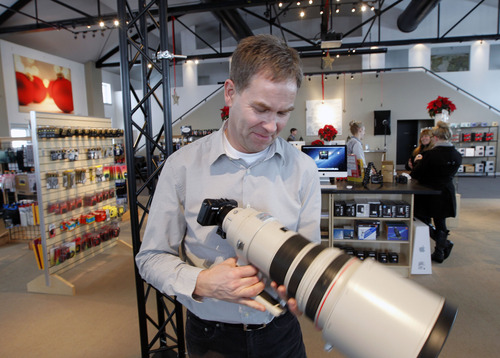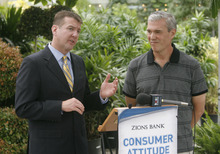This is an archived article that was published on sltrib.com in 2012, and information in the article may be outdated. It is provided only for personal research purposes and may not be reprinted.
Retailers nationally were left uneasy by consumers' slow pace of holiday spending, but at least three merchants in Salt Lake City either did better than last year or saw a last-minute surge that may have saved the day.
Across the U.S., shoppers spent cautiously, a disappointment for retailers who slashed prices to lure people into stores.
Sales of electronics, clothing, jewelry and home goods in the two months before Christmas increased 0.7 percent, compared with last year, according to the MasterCard Advisors SpendingPulse report.
That was below the healthy 3 percent to 4 percent growth that analysts had expected — and it was the worst year-over-year performance since 2008, when spending shrank sharply during the Great Recession. In 2011, retail sales climbed 4 percent to 5 percent during November and December, according to ShopperTrak.
In Salt Lake City's 9th and 9th district, many shoppers seemed to wait until the week before Christmas to pick up items at the Children's Hour, a small retailer of gifts, children's toys and apparel.
Owner Diane Etherington said sales started slowly in December, but just before Christmas Day, "everything flew off the shelves."
"People are uneasy about the future," said Etherington. "They waited until the last minute, and then said, 'To heck with it,' before they came in."
At nearby Weller Book Works, co-owner Catherine Weller said holiday sales were better this year than last, and well above projections. The book store moved from its longtime Main Street location last Christmas Eve, and opened in early January at Trolley Square.
"We saw many customers that we hadn't seen before," she said. "The importance of buying local is permeating the consciousness of a lot of consumers."
Elsewhere in Salt Lake City, Jens Nielsen, owner of the Pictureline at 305 W. 700 S. in Salt Lake City, saw an 11 percent increase in sales this season over last. He credits the boost to offering shoppers classes and instruction, as well as matching prices of the big-box stores. Also, several other camera stores had closed.
"Sales have been good all year," he said, noting that only 15 percent to 18 percent of his sales come during the holidays.
For most merchants, final sales numbers are still coming in, but it looks like revenue for the holiday season, from late October through December, will be "soft, which is disappointing because merchants typically do 30 percent to 40 percent of their business during" that period, said Dave Davis, president of the Utah Retail Merchants Association.
It's also likely that holiday sales will be a bit better than last season, but not by much when inflation is taken into account.
"Black Friday started out strong, so retailers were optimistic, but it seems that people started pulling back," he said. "It may have had to do with Washington [and the] the fiscal cliff, and looming tax increases. Anytime there's uncertainty, consumers usually will take a wait-and-see approach to spending."
This year's shopping season was marred nationally by that uncertainty and bad weather. Some analysts say the massacre of schoolchildren in Newtown, Conn., earlier this month may also have chipped away at shoppers' enthusiasm.
This season's weak sales could have repercussions for 2013. Retailers will make fewer orders to restock their shelves, and discounts will hurt their profitability. Wholesalers will buy fewer goods and orders to factories will likely drop in the coming months.
Steep discounts weren't enough to get people into stores, said Marshal Cohen, chief analyst at the market research firm NPD Inc.
"A lot of the Christmas spirit was left behind way back in Black Friday weekend," Cohen said, referring to the traditional retail rush the day after Thanksgiving. "We had one reason after another for consumers to say, 'I'm going to stick to my list and not go beyond it.' "
Spending by consumers accounts for 70 percent of overall economic activity, so the eight-week period encompassed by the SpendingPulse data is seen as a critical time not just for retailers but for manufacturers, wholesalers and companies at every other point along the supply chain.
The SpendingPulse data released earlier this week, which captures sales from Oct. 28 through Dec. 24 across all payment methods, is the first major snapshot of holiday retail sales. A clearer picture will emerge next week as retailers like Macy's and Target report revenue from stores open for at least a year. That sales measure is widely watched in the retail industry because it excludes revenue from stores that recently opened or closed, which can be volatile.
The Associated Press contributed to this story Consumers wary of next 6 months
Consumer confidence in Utah and throughout the nation tumbled in December, driven lower by fears of sharp tax increases and government spending cuts that could take effect next week.
The Zions Bank Expectations Index — an estimate of Utah consumer confidence in the economy six months from now — fell in December. The Index dropped 9.1 points, to 78.2, while the national index dropped 14.4 points, to 66.5.
When Utah consumers were asked if the U.S. economy would improve during the next 12 months, 52 percent indicated that it was unlikely, compared with 32 percent just two months ago.
Over the past 12 months in Utah, the index climbed 21.4 points as business conditions and job opportunities in the state improved. However, during that same time, economic optimism has declined.
"It has been our state's resiliency, business-centric policies and educated work force that has propelled our economic recovery ahead of many other states," Scott Anderson, president and CEO of Zions Bank said in a statement. "However, a number of macro-economic factors over the last 12 months have swayed consumers' long term confidence, specifically the U.S. debt crisis, Europe's recession and China's economic slowdown."









